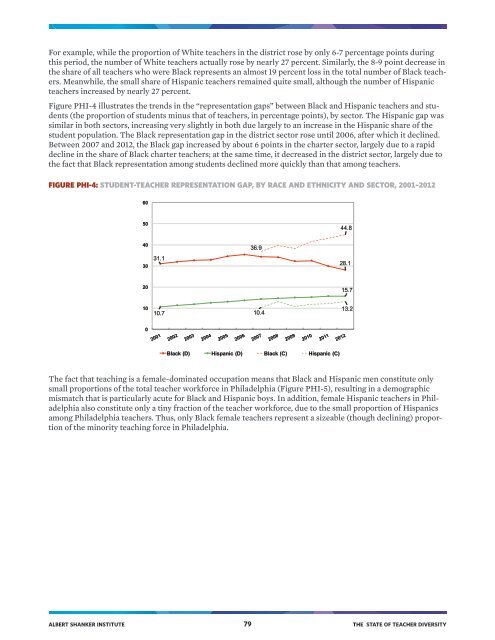TEACHER DIVERSITY
The State of Teacher Diversity_0
The State of Teacher Diversity_0
- No tags were found...
You also want an ePaper? Increase the reach of your titles
YUMPU automatically turns print PDFs into web optimized ePapers that Google loves.
For example, while the proportion of White teachers in the district rose by only 6-7 percentage points during<br />
this period, the number of White teachers actually rose by nearly 27 percent. Similarly, the 8-9 point decrease in<br />
the share of all teachers who were Black represents an almost 19 percent loss in the total number of Black teachers.<br />
Meanwhile, the small share of Hispanic teachers remained quite small, although the number of Hispanic<br />
teachers increased by nearly 27 percent.<br />
Figure PHI-4 illustrates the trends in the “representation gaps” between Black and Hispanic teachers and students<br />
(the proportion of students minus that of teachers, in percentage points), by sector. The Hispanic gap was<br />
similar in both sectors, increasing very slightly in both due largely to an increase in the Hispanic share of the<br />
student population. The Black representation gap in the district sector rose until 2006, after which it declined.<br />
Between 2007 and 2012, the Black gap increased by about 6 points in the charter sector, largely due to a rapid<br />
decline in the share of Black charter teachers; at the same time, it decreased in the district sector, largely due to<br />
the fact that Black representation among students declined more quickly than that among teachers.<br />
FIGURE PHI-4: STUDENT-<strong>TEACHER</strong> REPRESENTATION GAP, BY RACE AND ETHNICITY AND SECTOR, 2001–2012<br />
60<br />
50<br />
44.8<br />
40<br />
36.9<br />
30<br />
31.1<br />
28.1<br />
20<br />
15.7<br />
10<br />
10.7<br />
10.4<br />
13.2<br />
0<br />
Black (D) Hispanic (D) Black (C) Hispanic (C)<br />
The fact that teaching is a female-dominated occupation means that Black and Hispanic men constitute only<br />
small proportions of the total teacher workforce in Philadelphia (Figure PHI-5), resulting in a demographic<br />
mismatch that is particularly acute for Black and Hispanic boys. In addition, female Hispanic teachers in Philadelphia<br />
also constitute only a tiny fraction of the teacher workforce, due to the small proportion of Hispanics<br />
among Philadelphia teachers. Thus, only Black female teachers represent a sizeable (though declining) proportion<br />
of the minority teaching force in Philadelphia.<br />
ALBERT SHANKER INSTITUTE 79 THE STATE OF <strong>TEACHER</strong> <strong>DIVERSITY</strong>


